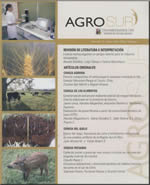COMBINATIONS BETWEEN IRRIGATION AND CUTTING FREQUENCIES OF RYEGRASS PASTURE IN SOUTHERN CHILE
Main Article Content
Abstract
The trial was conducted near Melefquén, province of Valdivia, Chile, between October 2007 and April 2008. The main objective of the study was to evaluate different combinations of irrigation and cutting frequencies of a sown ryegrass pasture. The study was based on a randomized complete block design, with a factorial arrangement of 2x3, combining 3 irrigation frequencies and 2 cutting frequencies. Three blocks were used, with the six treatments. Irrigation levels were programmed with a pan evaporimeter, using 1) Less frequent irrigation (RPF), with a high irrigation level of 80 mm applied each time the pan evaporimeter showed an evaporation of 40 mm and 2) Frequent irrigation (RF), using an irrigation level of 40 mm each time the pan evaporimeter showed an evaporation of 20 mm. In both cases, water was applied using microjets. 3) Without irrigation (SR), which was the control for the study. The two cutting frequencies were: cutting every 15 days (C15), simulating a direct grazing, and cutting every 45 days (C45), simulating forage conservation. In both cases, a residual height of 8 cm was used. The highest production was obtained with treatment RF 45, reaching 18.022 kg MS ha-1 and the lowest production was obtained with treatment SR 15, reaching 6.279 kg MS ha-1. For the irrigation treatments, only the treatment without watering (SR) showed a signifcant difference compared to frequent (RF) and less frequent irrigation (RPF). No differences were found between the two treatments with irrigation. Irrigation produced no significant differences in terms of the nutritional parameters of the forage. Cutting frequency did, however, have a significant impact on the pasture metabolizable energy (ME) content with cutting every 45 days resulting in higher ME contents than cutting every 15 days.

